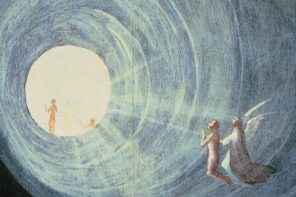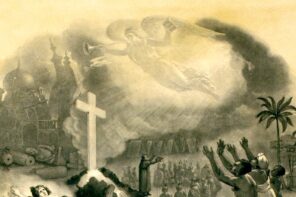Mo Willems’ Leonardo, The Terrible Monster, tells the story of the eponymous creature who can’t “scare the tuna salad” out of anyone. Unlike the other monsters, Leonardo wasn’t big like Eleanor, didn’t have 1,642 teeth like Tony, and “he wasn’t just plain weird like Hector.” As Willems, one of my favorite children’s book authors, gets it, you don’t need to be super-sized or have a large number of teeth—something everyone else already has—you just need to be “plain weird” to be a good monster. And we need our monsters, harbingers of the wild and chaotic, as they warn and protect, de-monstrating from the world beyond that which is known.
Jeff Sharlet taught me that religion is weird. He described it as such in a lecture a few years ago and in personal conversations since, though as a scholar of religious studies I already knew that. Well, sort of. At first I recognized Sharlet’s phrasings through the more familiar scholarly terminology of “strange.” Strange is a homey term for us academics, having entered through Germanic-French psychoanalytic traditions (Freud, Lacan, Kristeva); strange hints at something out of the ordinary, yet still grasping at its connections to normalcy. The stranger is other, yet recognizable in a generic kind of way. Critically speaking, the strange can be theoretically tamed. That’s what we scholars of religious theory are taught, and teach others, to do: tame the strangeness of myths and rituals and symbols.
Weird is weird. That which is weird is something other to that which is strange. And Sharlet’s Sweet Heaven When I Die tells tales of religious weirdness, which is also to say the wildness, the wilderness, the untamable regions. If we don’t make space for the weird in religion, we simply don’t get religion in all its complexity, its messiness, and its wild parts.
The Weird is Out There
For Jeff Sharlet, in Sweet Heaven and other writings, the weird is out there: lost in the Wild West and a crowd of neo-revivalists in a Cleveland auditorium; hidden behind suburban fences and dark, ideologically-charged Hell Houses; on scratchy 1920s blues recordings and Mennonite funerals. Sharlet’s rare gift has been to make friends with the weird and almost, but not quite, make peace with it. Which doesn’t mean he’s not rightly skeptical of the abuses of religious traditions.
Two of his previous books, C Street and The Family, are strongly critical of the exploits that can come from weird religion. And in Sweet Heaven, there are plenty of places where the criticisms arise, however subtly; in descriptions of Ron Luce’s BattleCry crusades, the greedy gurus of New York/New Age mysticism, media tycoons, or late night apocalyptic radio preachers. The practitioners of weird religion aren’t all ones that we (liberals anyway) want to welcome into our homes, but in these essays Sharlet is careful to notice the humanity of the people he is writing about. In good liberal fashion, there would seem to be no one beyond redemption (though some might need a bit more atonement than others).
The placement of the first essay, “Sweet Fuck All, Colorado” (you’ll have to read it to get the title), is significant. Here Sharlet reminisces about, and later revisits, a college girlfriend; the two of them seemed to see things eye to eye in early adulthood, but years later as Sharlet visits her rural Colorado digs, he realizes the divergent paths that personal journeys can take. In setting up the book this way, there is an implicit notion that his life is actually not so far from another life. A step in one direction or another can change everything.
Emplotment
What strikes me most in Sweet Heaven is the way Sharlet “em-plots” religious interests and events. I mean that in three ways. First, he finds stories—and creates them where they are not apparent—in places most of us refuse to look, and probably wouldn’t find had we wanted to. The plots are out there. What might seem like random events to most of us become a narrative arc under his gaze—even and especially when the arc doesn’t quite come back down. My favorite line in a book full of great lines is this: “…it’s just that we’re bound to stories that don’t so much resolve as unravel.” He’s talking about himself and his friend Ann here, and some of the narrative parallels in their lives. But it can be equally applied to so many of our lives, surviving in the fray. We are living stories, plotted in the entanglements of the world. Resolution is not an option. At least, not a human option.
“[T]he mountains for some people are not so much a promised land as a place to which to retreat, after the little wars of individual lives have been fought, lost, and run away from.” In lines like this one, Sharlet “emplots” religion by making spaces and things real to readers; gives them a plot of land. Life and love and religion are tangible, physical things, with stories set into spaces and narrative plots into geographic plots. His people, places, and things are inseparable, and co-create each other. There’s no Molly without Salida, Colorado, just as there is no Lancaster County without Ann. Books make Cornel West, and Chava Rosenfarb makes books. Ron Luce needs auditoriums within which to amplify his ego, and a video camera makes Brad Will a martyr. Meanwhile, Luce needs the wide-open space of east Texas to ground a globetrotting evangelistic enterprise, while Will’s globetrotting activism leans on his grounding in Kenilworth, Illinois. Plots are constantly plotted.
Ultimately, emplotting people’s tales and locations entails their humanity, and hence we stumble over the third emplotment, the cemetery plot. In “Begin with the Dead,” Cornel West offers his attitudes toward teaching and all other manner of life. As Sharlet paraphrases West:
To be a scholar of the humanities—to be human—is to begin with the dead, to see that our futures are linked to our pasts, to acknowledge, deep in our bones, the truth of our own dying selves, ‘from womb to tomb,’ West says.
The earth-born, earth-bound human equivocates and democratizes in the most profound of ways. If we realize our potentials and entrapments, we realize also the ways we live out our lives through narrative plots, live in the defining bounds of geographic plots, and end up in plots of ground. In the middling the struggle is born, to start and stop, to try and halt, and try again. In the dying pages of Sweet Heaven, Sharlet offers his own take: “We are none of us human yet, only trying and quitting and trying and tiptoeing out the back door.”
Maps for the Weird
Sweet Heaven When I Die blurs lines between investigative journalism and pilgrimage, detailing journeys that are investigative pieces, and investigations that are journeys. Journalism and journeys are never far apart, even in their etymology. Good journalism charts maps of journeys; it lets us know about other plots that have transpired along the routes we are taking, as we plot our own lives. Writing is cartography, and Sharlet seeks this: “I’ve been looking for a map, directions, a way to get there.”
But Sharlet is no penitent on hands and knees. Why, we might ask, considering the bifurcations of the first essay, did Sharlet become a great, incisive writer with a strong sense of social justice and not, say, a Berliner in love with Jesus, or a chain-smoking cowboy on the edge of the old West? Answers are not given, for there is no transcendent-guiding force in Sharlet’s worlds. As he ends the book: “This is not a redemption story. Born Again? Christ, no. We’re still waiting to be born. Not waiting; hoping.”
Reviewers of Sharlet’s previous books such as Killing the Buddha and Believer, Beware (both co-authored/edited with Peter Manseau) discuss his engagement with the “margins,” the “underexplored,” the “underbelly,” of religious faith in these United States. We might also add “strange” to the list, but I’m going to stick with “weird.”
Weird religion is by no means a negative qualifier, but rather an indication of how far people can go in their behaviors and beliefs, practices and piety, faithfulness and filiality. These extremes are part of what make us human in the first place. We need weird religion and Sharlet continues to provide maps for finding it, for finding ourselves. Weird religion should shake us up, wake us from dogmatic slumber, just as it guides us into the possibilities of a good life, of understanding the pasts and futures, the far away and the near at hand, and how they bear on the here and now.




